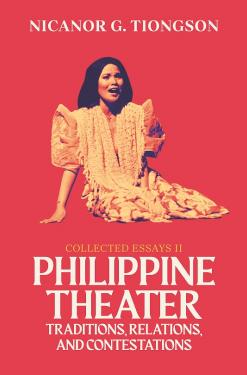
Volume 2: Philippine Theater Traditions, Relations, and Contestations
Philippine Theater Traditions, Relations, and Contestations, the second volume of Nicanor Tiongson’s trilogy of collected theater essays, is divided into three parts. The first, “Tradition and Innovation in Philippine Theater,” has one article illustrating how the traditional komedya, sinakulo, and sarsuwela, among others, have been revitalized with progressive messages; a study showing how Palasyo ni Valentin subverted the elements of the traditional sarsuwela to get the form out of its box; a personal account narrating how Ramayana drama traditions of Southeast Asia were transformed in ASEAN’s Realizing Rama through the process of “inter-creation”; an article showing how the Indian Ramayana was indigenized by Filipino artists in their literary, dance, and theater productions; and an analysis of how Jose Rizal’s two novels were contemporanized to expose the corruption behind illegal logging that devastates lives and properties. The second part,“Philippine Theater and Its Oriental and Occidental Relations,” traces the sources and influences of Philippine theater in an article describing three folk playlets found in both Mexico and the Philippines; a study showing how the Philippine sarsuwela descended from the Spanish zarzuela and Filipinized it; and an article showing how Japanese dramas influenced Philippine contemporary plays. The third part, “Contesting Ideas and Ideologies in Philippine Theater,” has an analysis of how three plays of 1902 espoused conflicting positions on the American invasion of the islands; a critique of the plays staged against the Marcos dictatorship in the Makiisa II festival of 1984; a description of how Manila theater groups responded to Rodrigo Duterte’s wars on drugs, truth, and memory; and a study of how the púsong (jester) embodied the voice of the people in Tagalog traditional and modern plays.
“In this book, the author has amply demonstrated that the theater in its myriad types, styles, configurations, and persuasions is inextricably linked to the Filipino’s life and culture. In this wide variety of forms that have evolved from the indigenous past through the long colonial periods of assimilation, interpretation, and continuing adaptation . . . the theater has become uniquely Filipino in its form, substance, character . . . and consciousness. For these insights and more, this book should be read by anyone seriously interested in Philippine theater—and culture.”
—RAMON P. SANTOS, National Artist for Music
Published in 2024.




